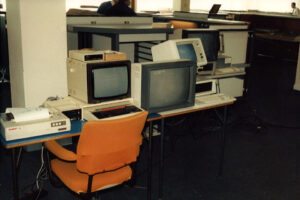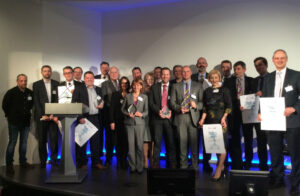Throughout my career in the Civil Service, I have seen many ‘revolutionary’ changes become the norm. Writing a blog, in itself, is one of those changes. So, let me tell you a little about my career working in government property.
Thirty-five years ago, I joined an organisation called PSA Supplies, a branch of the Property Services Agency (PSA). PSA Supplies provided all the office furniture and furnishings for government departments.
Tangerine dream

One of the memorable features of that era was the ground-breaking introduction of a design style called Schematics, which resulted in psychedelic seat covers on the ubiquitous tubular chairs we all used to sit on, and bright orange 4-drawer filing cabinets. This was quite a culture shock for civil servants accustomed to any colour so long as it was grey!
Armed with a palette of ‘approved’ colours, I raised eyebrows (and no doubt blood pressure) with my youthful choice of bright yellows, greens and reds for walls and doors in many a Social Security and Inland Revenue office throughout East Anglia. As well as not being used to it, colour in the office was something civil servants didn’t feel they ‘deserved’.
Because of my ‘success’, I was moved to the HQ design team in London, which worked on major property schemes, such as Crown Courts, and provided space planning (remember that?) for offices. The next big shock for civil servants was the introduction of the open-plan concept, enabled by the new infrastructure of underfloor cabling. Civil servants baulked at having to work in such conditions!
Novel concept
 At that time, there was an influx of regulations controlling how staff interacted with their new workspace: from the need to have rest-breaks from VDU screens, to how to lift those heavy boxes of ring binders off the floor. Managing the workplace was becoming an ever more complex activity.
At that time, there was an influx of regulations controlling how staff interacted with their new workspace: from the need to have rest-breaks from VDU screens, to how to lift those heavy boxes of ring binders off the floor. Managing the workplace was becoming an ever more complex activity.
Taking advantage of this new management specialism, I became a facilities manager. Facilities management (FM) introduced me to the novel concept of outsourcing, which allowed office services previously delivered by civil servants to be provided by the private sector. This made a lot of sense in the context of managing property, provided there was sufficient knowledge in-house to ensure quality of service and value for money. In other words, the generalist civil servant had to become more of a specialist, with the necessary skills to manage commercial activities. Sound familiar?
Any time, any place…
Such was the wider interest in FM that my next role took me to Sunningdale as a lecturer at the now defunct National School of Government, where I prepared fellow FMs for the British Institute of Facilities Management (BIFM) examinations. While there, I was introduced to the idea of flexible working, being championed by BT in their Workstyle 2000 initiative. BT predicted the rise of mobile technology that would free office workers from fixed locations to work almost anywhere. And so it was that I received my first government mobile phone in 2000 and my first laptop in 2003. Now, many of us work on laptops as standard and are able to work in more than one location.

To bring us up to date, the recent TW3 Awards showcased how departments and their staff have responded to new ways of working. It was an opportunity to hear the leading thinkers on the subject discuss what the future holds for civil servants and what it will mean for government property. No more vast edifices with a fixed desk and fixed population? Fewer long commutes? Civil servants trusted to work flexibly from a number of locations and continue to deliver great solutions?
Accelerating change
So, what’s the message? We have been experiencing change in the Civil Service for as long as I can remember. Grey is no longer a certainty but an option; open-plan layouts are the norm; flexible working practices, supported by modern technology, are improving the way we work; and civil servants are on track to develop the professional skills they need to perform at their best in a modern public sector.
But it isn’t going to stop here, and - if anything - the pace of change is going to accelerate.
We government property professionals must embrace change positively and use our expertise to help deliver this vision of a better, vibrant and empowered Civil Service. That will be another great legacy to pass on to our successors.

5 comments
Comment by lyn posted on
Still have orange filling cabinets in our office and a few green..
Comment by Andrew Howarth posted on
Wow, that's amazing Lyn. A few pictures would be good as I can't find any photographic record of these items or the way offices looked in the late 1970's. And if anybody out there has a copy of the old Schematics Guidance i'd love to know.
Comment by Richard Graham posted on
Sorry, don't have a copy of the Schematics Guidance, but I do have a copy of the Office Accommodation Standards Code (June 1980). This sets out the furniture, fixtures and fittings for particular types of room and the amount of space to be allocated (by people's grade...). Some interesting room types: "Sandwich Lunch Room", "Snackeries" etc. Plenty of references to "Chair, Steel Tubular" with and without arms, but I understand that "Chair, desk swivel" was only available for typist grades and VDU operators. How we "shiny a***d clerks" had to suffer for our art, back in the day!
Comment by Bridget Hardy posted on
For goodness sake Andrew, I remember those chair covers too! Quite a shock to the eye when I started work. Sad that Civil Setvants felt they didn't 'deserve' colour, or a decent modern workplace. I hope that's changed.
Comment by Richard Graham posted on
Great piece Andrew. Now at last it has been revealed - the person responsible for those psychedelic chair covers fondly remembered by many Civil Servants of a certain age!
Interesting that open plan office layouts are no longer considered the best environment for much of the work we do. Choice is the watchword now and a lot of people can choose not to come to the office at all to work. How times change - but no, you can't redesign my house!